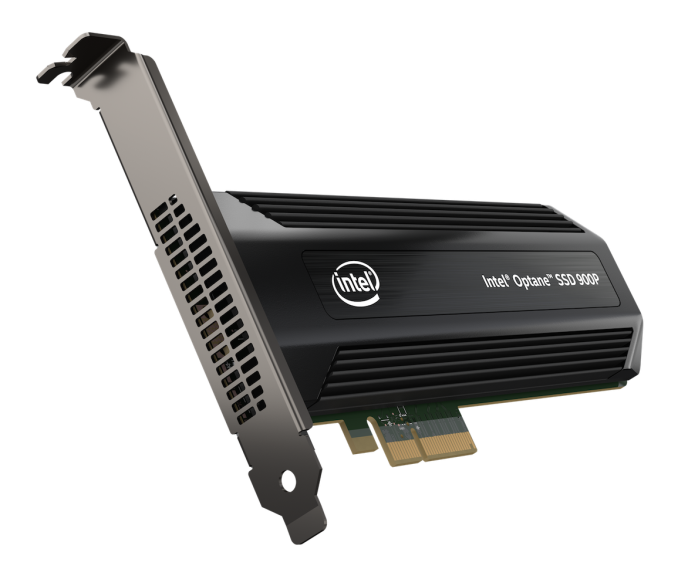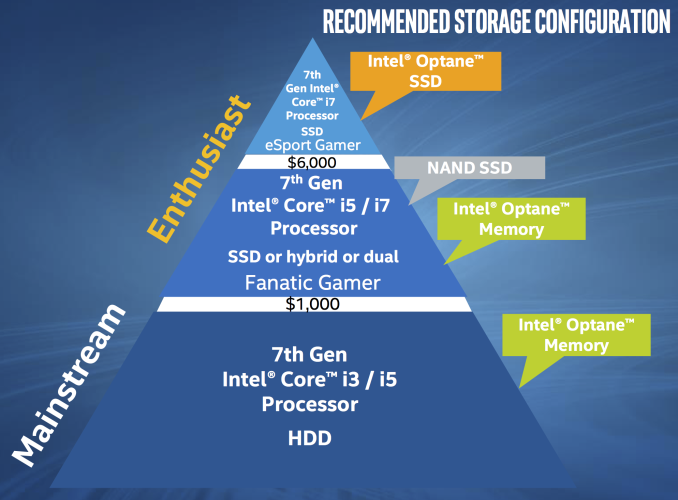The Intel Optane SSD 900P 280GB Review
by Billy Tallis on October 27, 2017 9:30 AM EST
Whenever Intel develops a new generation of SSDs based entirely on in-house technology, the result is usually a product that turns heads. Several times, Intel has set a new standard for SSD performance, starting with its original X25-M. Their most recent shake-up of the consumer SSD market was the Intel SSD 750, the first consumer NVMe SSD. Such significant releases don't happen every year, and in the intervening years Intel's competitors always catch up and surpass Intel.
However this year's revolution from Intel will be very hard for the competition to match anytime soon. All of Intel's previous record-setting SSDs have relied on the drive's controller to stand out from the crowd. This time, Intel's advantage comes from the storage medium: its 3D XPoint memory technology, a new nonvolatile memory that offers much higher performance than flash memory.
The Intel Optane SSD 900P
The new Intel Optane SSD 900P is a premium NVMe PCIe SSD offering the highest level of performance, with a moderate capacity. The Optane SSD 900P is intended for high-end desktop systems and workstations with very disk-heavy workloads. The Optane SSD 900P isn't for everyone and won't be displacing any existing products - it exists alone in a new product tier, with prices that are more than twice what the fastest flash memory based SSDs are selling for.
Optane is Intel's brand name for products featuring 3D XPoint memory. The Intel Optane SSD 900P is actually the third Optane product to be released, but it's the first family member to go after the high end consumer market segment. The Intel Optane Memory M.2 drives released earlier this year have capacities far too small for general-purpose storage use and instead have been marketed for use as a cache device to be paired with a mechanical hard drive. Intel's caching strategy works and can bring a hard drive's responsiveness up to the level of mainstream SSDs, but it has downsides. The Optane Memory caching requires a few extra steps to setup, and the caching software will only run on Intel platforms introduced this year: Kaby Lake or newer.
The Optane SSD DC P4800X is Intel's flagship enterprise SSD, and it is priced accordingly—putting it far out of reach of consumer budgets, and even with a price tag of over $1500 for 375GB it has been quite difficult to acquire. In the enterprise storage market, the P4800X has been highly sought after, but it isn't appropriate for all use cases and is not a threat to the many enterprise SSDs that prioritize capacity over performance and endurance.
The Optane SSD 900P will still cause some sticker shock for consumers expecting prices in line with M.2 PCIe SSDs, but it is acceptable for the kinds of machines that might be packing multiple GPUs or 10+ CPU cores. The Optane SSD 900P probably wouldn't be the only drive in such a system, but it would work well as a blazing fast primary storage device.
| Intel Optane SSD 900P Specifications | ||
| Capacity | 280 GB | 480 GB |
| Controller | Intel SLL3D | |
| Memory | Intel 128Gb 3D XPoint | |
| Interface | PCIe 3.0 x4 | |
| Form Factor | HHHL Add-in card or 2.5" 15mm U.2 |
HHHL Add-in card |
| Sequential Read | 2500 MB/s | |
| Sequential Write | 2000 MB/s | |
| Random Read IOPS | 550k | |
| Random Write IOPS | 500k | |
| Power Consumption | 8W Read 13W Write 14W Burst 5W Idle |
|
| Write Endurance | 10 DWPD | |
| Warranty | 5 years | |
| Recommended Price | $389 ($1.39/GB) | $599 ($1.25/GB) |
The Intel Optane SSD 900P is initially launching with 280GB and 480GB capacities. Both sizes will be available as PCIe 3.0 x4 half-height half-length add-in cards, and the 280GB model is also available as a 2.5" U.2 drive. Higher capacities may be added later, but Intel isn't promising anything yet. The sequential transfer speeds are nothing special for a NVMe SSD these days—Samsung's 960 PRO can hit much higher read speeds and slightly higher write speeds. The random read and write IOPS are far higher than any consumer SSD has offered before.
Intel's specifications for power consumption show one big reason why the Optane SSD 900P is a desktop-only product. Laptops are not equipped to supply up to 14W to a SSD, and they usually aren't equipped to cool a drive that idles at 5W instead of 50mW. The level of performance offered by the Optane SSD 900P cannot currently fit within the power budget or space constraints of a M.2 card.
The five year warranty Intel offers is typical for a high-end SSD in today's market, but doesn't compare to the 10 year warranty that Samsung's flagship 850 PRO SATA SSD offers. On the other hand, the 10 drive writes per day write endurance rating is far higher than most consumer SSDs get; 0.3 DWPD is more typical.
The Intel Optane SSD 900P starts shipping worldwide today, and here is our review of the 280GB version.











205 Comments
View All Comments
investlite - Monday, November 6, 2017 - link
I bet you're still pissed we don't have flying cars. OMG, do you go to every new car unveiling and talk about how crappy each new car is because we were supposed to have flying cars by now?Gothmoth - Friday, October 27, 2017 - link
when you do huge particle simulations you will want the fastest SSD you can get.ddriver - Friday, October 27, 2017 - link
I've been doing that, for VFX as well as multiphysics simulations for over a decade. It has always been an in-memory thing. It doesn't seem they simulated it, it seems they read baked simulation data, and stored in some insanely inefficient manner at that.As I implied, this has got to be a new record in rigged benchmarks. Shame!
extide - Friday, October 27, 2017 - link
Sigh, the Optane drive didn't improve the performance of reading the data into the simulation. The simulation required (significantly?) more RAM than the system had. They put a big swap file on either a 960 PRO or on the Optane drive. It probably doesn't even matter where the simulation data was stored.ddriver - Friday, October 27, 2017 - link
Well, they should have bought moar ram then. Then maybe they could have kept that CPU busy at 100% and get much better time.I mean it is not like hypetane offers terabytes of capacity. Topping at 480 GB - that's entirely doable in RAM. More expressive - sure, but nonetheless a perfectly sensible investment if you are doing such simulations. It will pay for itself, as RAM is tremendously faster, and also doesn't wear, at least nowhere nearly as much as xpoint does.
extide - Friday, October 27, 2017 - link
For that particular case, sure, maybe more ram is the way to go, but there are plenty of cases where the drive is better, like several of the ones I mentioned above. Most of those rely on the non-volatile aspect, which obviously RAM doesn't have.ddriver - Friday, October 27, 2017 - link
As I said - it has its advantages and uses. I also said I might even buy it.And the only reason I call it hypetane is because intel shamelessly lied about it, and continues to cheat in order to make it look good even after it became evident that it is not anywhere nearly as good as they initially claimed, and call me old-fashioned, but I have a problem with that.
It boggles the mind that people around here have such a problem with me just because I don't have my tongue up intel's rectum...
ddriver - Friday, October 27, 2017 - link
BTW, 1.1 billion particles, presuming the simulation is ran in FP64 mode, with x y and z coordinates for each particle would only require about 24 gigs of ram.Which raises the question, did they allocate each of those points on the heap or something?
ddriver - Friday, October 27, 2017 - link
Opsie, silly me, it would take another 24gb for the vector of force for each particle. Now it is a little more plausible that 64gb might not be enough.CaedenV - Sunday, October 29, 2017 - link
Sure, in a perfect world you buy more RAM. But if you are in a situation where you don't have infinate cash and you can buy more RAM at $7/GB or an Optane SSD for ~$1-2/GB then Optane begins to look a bit more appealing. A 480GB drive running as cache for $600 vs 480GB of DDR4 at $3350.... that would make almost anyone thing twice.Or in the case of my work, we have a bunch of clustered servers, and we are maxxed out on ram but not yet ready to do a server upgrade (hoping to get 2 more years out of them), but we need more fast cache for a bunch of different applicaitons. The idea of running those caches on this kind of SSD sounds a lot more appealing than running on traditional SSDs.
But yes, when we upgrade servers, we will simply have more RAM on board. That is the obvious solution. But when a motherboard can only hold 256GB of RAM and you need more... life is often about compromises, and Optane tech sounds like a good compromise. But what you would use this for in daily life or in a normal computer? Man, that totally beats me! This product is almost too cheap for what it is good for (business class SSDs typically cost more than $1.25/GB still and are far slower than consumer SSDs), and completely useless and overpriced for that they are advertising it for.